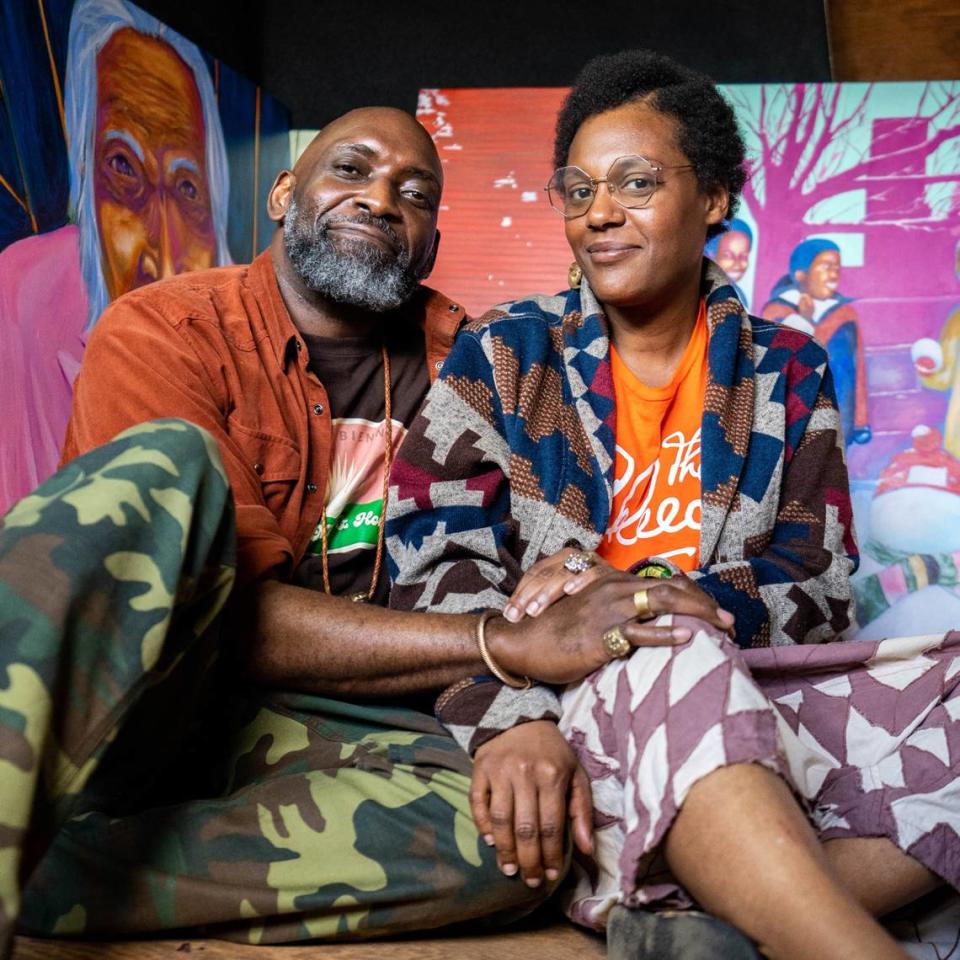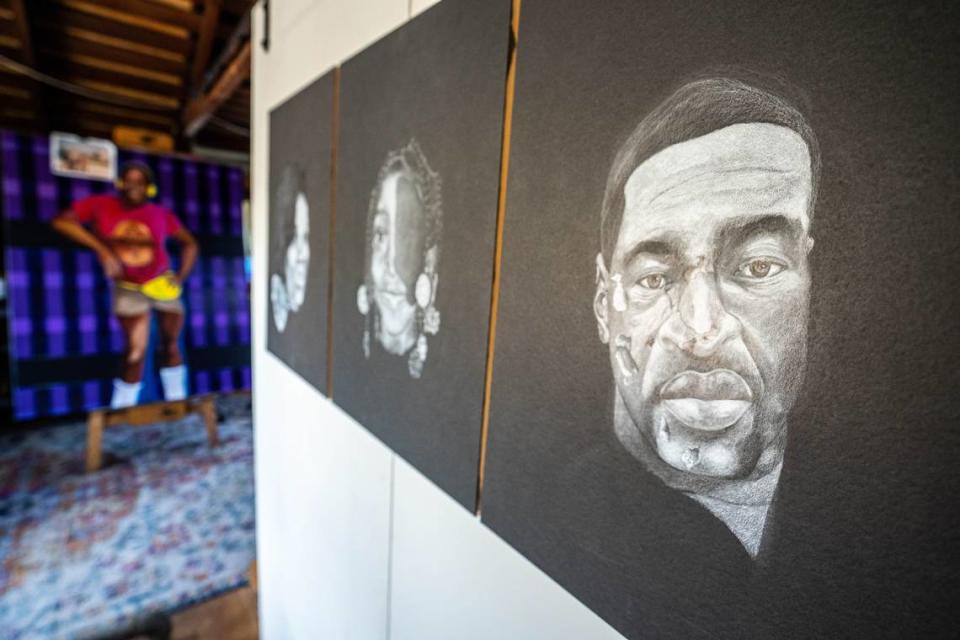Sacramento-based couple finds art world success by exploring race, history and mythology
Jessica Wimbley’s hair has a story to tell.
Wimbley, who lives in midtown with her husband and fellow artist Chris Christion, has a piece in the stairwell near Crocker Art Museum’s main entry entitled, “The True Story of Edges.” Anyone who heads from the first floor to galleries on the second and third floor will see two back-to-back videos of Wimbley that highlight the edges of her hairline.
“That’s used a lot within the African-American community to denote what your hair texture is,” Wimbley said. “And within this particular video, I’m using my hair as a space for storytelling.”
Different images interweave with Wimbley’s Afro in the video. For Wimbley, the story she’s telling is both personal and reflective of the protest movement that’s seen a resurgence in America in recent years, highlighted by the response to George Floyd’s 2020 murder.
It’s only the latest work from Wimbley or her husband, artists who moved together to Sacramento in 2018 and are making names for themselves in both Sacramento and beyond.
“The thing I like about Jessica and Chris is that they take what they do really seriously and they’re really invested in it,” said Liv Moe, founder of Verge Center for the Arts, a gallery and creative space near Southside Park.
Getting to Sacramento
Before they were husband and wife, a collaborative team and Sacramento residents, Wimbley and Christion were artists. Each began studying painting as undergraduates in the 1990s, with both later earning MFAs in the 2000s. Wimbley is now 43, while Christion is roughly five years older.
Christion’s professor and mentor during his undergraduate days at University of Oklahoma was Edgar Heap of Birds, whose last name reflects his Cheyenne heritage. Heap of Birds remembered his student working often with tactile fabric to make small sculptures. “It was always making his own kind of world that was really provocative,” Heap of Birds said.
Christion grew up the son of a pastor and comes across shy, self-effacing and unfailingly polite. Longtime friend Crystal Z Campbell, who also studied at University of Oklahoma, said she met Christion when Heap of Birds invited them both to dinner.
“I think both of us are very soft-spoken,” Campbell said of Christion. “So I remember having a difficult time hearing him and it was honestly the same.”
Wimbley presents as more extraverted than Christion.
Mollie Oblinger, an associate professor of arts at Ripon College in Wisconsin, became friends with Wimbley while they were each pursuing an MFA at UC Davis. Oblinger recalled attending a wedding around this time and bringing Wimbley as her plus one.
“We ended the wedding by taking all of the little disposable cameras,” Oblinger said. “We shot all the rest of the pictures with us and the bartenders that we drug onto the dance floor as I recall.”
Wimbley and Christion met in 2008 at the LA Art Show – which bills itself as America’s most comprehensive international show, at more than 120 galleries, nonprofits, and museums – when they were both living in Southern California.
They married in 2012 and moved to Sacramento in 2018 for Wimbley to take a role as director of education at UC Davis’ Manetti Shrem Museum of Art.
Wimbley left the UC Davis job in late 2019, though she and Christion have remained in the Sacramento area. Since then, they have experienced more success in their artistic careers, in part by starting to collaborate with one another.
Working together
Since their days in Southern California, Wimbley and Christion had been working together as curators, putting together exhibitions around an idea coined by the late poet Audre Lorde known as biomythography. This idea, which combines historical and mythological themes, is close to their hearts. Christion even created a course on it at UC Berkeley, where he teaches.
“It gives you a way to speak across disciplines, across communities,” said Christion, who also commutes to teach at Stanford.
Wimbley and Christion are each Black, with Christion having Louisiana Creole heritage and Wimbley being of mixed German heritage.
The two began making art together during the pandemic, creating work rooted in historical themes. They draw attention to areas like Folsom Lake’s Black Miners Bar – where African-Americans discovered gold – or the practice of mortgage redlining that for decades restricted where Black people could own homes.
One thing that’s clear: There’s an audience for this work.

An eight-minute video that Christion and Wimbley created, “The Unauthorized Histography of California Vol. 2: Fieldnotes, 2022” is on display through May 28 at The Cheech Marin Center for Chicano Art & Culture of the Riverside Art Museum in that Southern California city.
The center, which opened last year, is dedicated to Mexican-American artists and to work that celebrates that culture. Marin, the 76-year-old comedy legend and veteran character actor said in a phone interview that he sees a shared heritage between Black, Native American and Mexican-American people.
“It’s an outsider’s point of view, people who have been kind of not allowed into the news or sheltered from the museums,” Marin said. “It’s a tough road, because there’s no math behind you to push it into the limelight.”
Local success
Marin created his Riverside center in part to showcase works from his personal collection that he’d been accumulating since the 1980s. Locally, efforts to showcase more artists of color since Floyd’s murder in 2020 could be creating opportunities for artists like Christion and Wimbley.
Christion and Wimbley collaborated on a 2 minute, 34 second video in 2021, “Fieldnotes: Califia” that went on display in the lobby of the California Natural Resource Agency in downtown Sacramento.
In recent months, Wimbley sold her piece to the Crocker, which had made an agreement two years ago with the Kingsley Art Club to “find $10,000 a year for five years to support the BIPOC community,” said William Ishmael, a member of the latter club. Wimbley declined to say how much she received for this sale.
Scott Shields, the Ted and Melza Barr chief curator and associate director at the Crocker, said that the Kingsley Art Club, a local organization that has existed since 1892, hadn’t previously done acquisition work but “saw what was happening and thought that they needed to help.”
Shields added that the club hasn’t been alone in these efforts.
“We’ve had some some other really great supporters recently, especially in the wake of George Floyd that stepped up and said, ‘We really want to help you in this,’ which is great, because we’ve never had a lot of money to spend, we always rely on donations to make acquisitions,” Shields said.

Wimbley was the fourth artist to receive an award through the agreement between the Crocker and Kingsley. “She has a message,” Ishmael said. “But it’s a message that doesn’t beat you over the head.”
Franceca Wilmott, who began as an associate curator with the Crocker in January, had become familiar with Wimbley’s piece during an exhibition last year.
“I think for me, the most interesting thing about this work and her work in general, is this layering of different narratives,” Wilmott said. “And so she’s really kind of deconstructing this idea that race is a social construction and identity is as well.”
More opportunities could emerge for artists like Wimbley and Christion that tackle social issues. Melissa Cirone, arts program manager for the city of Sacramento, said she was working on a grant application for the local region of the California Creative Corps. Artists could receive grants through this program to do work on issues like social justice and climate mitigation.
Already, though, Wimbley said Sacramento has been an amazing place for her and her husband.
“It’s been a really warm and welcoming community,” Wimbley said. “So it feels for us like this is a place that you can live and make and have support.”

 Yahoo Movies
Yahoo Movies 